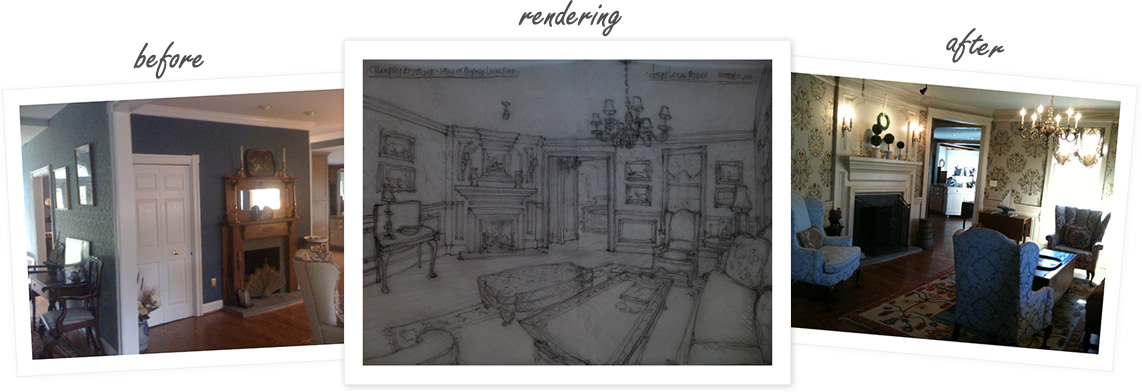RESIDENTIAL DESIGN
COMMERCIAL DESIGN
INTERIOR ARCHITECTURE
How It Happens
Once you've decided to start your project, it's sometimes confusing to know where to begin if you're not familiar with the process: who does what; when do they become involved; what to expect from each player. In this section, I'd like to share my experience, to help clarify the overall view from beginning to end, and to talk specifically about what I can do, for my part, to help get you there smoothly.

Establish What You Want
Your first step is to establish as clearly as possible what you want. Decide what you absolutely must have, what might be optionally nice, and what you know you do not want. Look at media to help crystallize your dream of how it looks/works. Everything: movies, books, magazines, the internet, old family photographs or memories- can help with this. Begin collecting images.
How Long Will You Stay?
Next, think of how long you plan to occupy the space you're going to create. Will you move in 5 years? This can be a very important factor in creating a budget idea for the project, but it also may guide how 'generally appealing' versus how 'specific to you' the project should be. Not everyone may want to take care of that 10 foot long salt water aquarium partition you love, when you're ready to sell.
Decide Your Budget
Budget idea. It's very important to have at least a general one, before you begin. Aside from educating yourself on what comparable projects in your vicinity are costing (consulting several builders can help with this), it's as important to decide how much you are comfortable spending.
To help with this, think of how often you'll use the space you're creating. Also as I mentioned, decide how long you'll stay, remembering that you may take some items when you move. If reclaiming your investment at resale is an important factor, then finding the recent sale amounts of comparably improved projects in the vicinity can help establish a 'dollar range' of investment vs. potential return, now.
Selecting A Builder
Thus prepared, you may next select a builder, a design/build builder (with or without on-staff architect), an architect, and/or a designer. Any of these professionals can be your starting point; what's important is that, as the team grows, there is a clear establishment of task responsibility, and chain of decision making responsibility, with a 'point' person to coordinate the others.
With the exception of the builder, then, one of these professionals begins to create the general 'concept' design with you. The concept design, when it's presented, should be specific enough to proceed to a full blown design if you like it generally, and loose enough to allow some modification, if those are wanted. If the professional was listening, it should be about 50% in the direction you imagined. Another round of modification or two is usual, to have the design ready for the next step.
Renderings
One of the very useful tools I use to help clients envision how the whole project will look when finished is a rendering or two of the space. Ideas that look abstract and incomprehensible in a technical plan come to life and make sense when seen as a camera might show them. For projects of any complexity, they help clients and contractors see how it 'all goes together'.
At this point, there are two options. One is to proceed right to design documents, those technical drawings and specifications necessary for all trades to construct and coordinate your project, together. This option is best if time is of the essence, and the budget is flexible. The other is to consult with the contractors who will be involved, with the concept drawings as they are, to collect rough estimate or 'ballpark' prices. This is a good option when budget is primary. I find clients are more comfortable with the latter approach; adjustments can be made beforehand, so that the possible additional cost of modifying the design documents after they are produced is avoided.
Regardless of the above choice, then, the design documents will need to be produced. Once those are completed and distributed to all the trades working on the project, the professional who is responsible for scheduling (usually the 'point person') will begin to work with you and them to create a timeline for the overall job, sequence their work and act as coordinator between everyone.
Execution
The final phase of professional involvement is the overseeing of the project's execution. Part of the step: 'sequencing of the trades' work', will have been to establish key times for the 'point person' and all or part of those trades to meet, to answer questions about where their work will interweave. It is important that the 'point person' be aware of decisions made throughout the course of the project, both at these meetings and during the progress of individual trades' work, to coordinate how any resulting changes will affect the overall design and other trades, and to communicate those as required.
I am usually the 'point person' on interior renovation projects, and sometimes on new architectural work, whether or not involving a 'design/build' builder or architect- however, I work easily in a design support capacity, as well.
The services I'm able to offer in the overall process then, include developing a program based on your requirements; measurement, photography & notation of your project's site conditions; creation of as built design plans, and a conceptual design based on it This might include the following: architectural/interior architectural modifications, millwork/cabinetry designs, lighting, furniture layout/selections, fabrics and/or finishes. I am able to create design documents to facilitate the execution of the approved final design. Finally, I can administrate the execution of the design, covering all phases of the process, as you need.